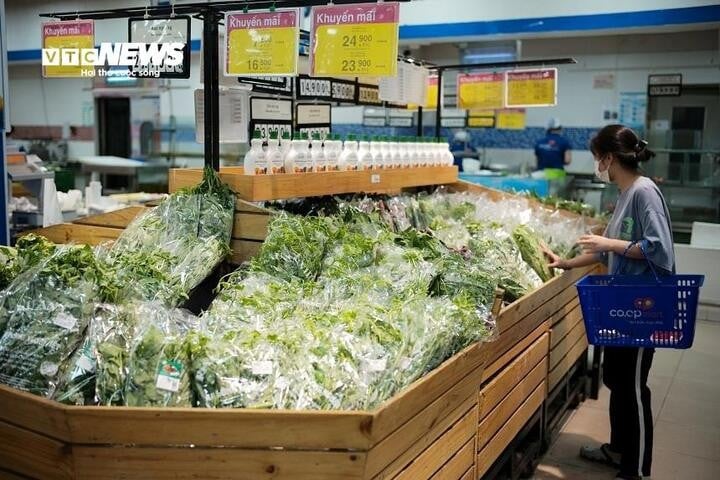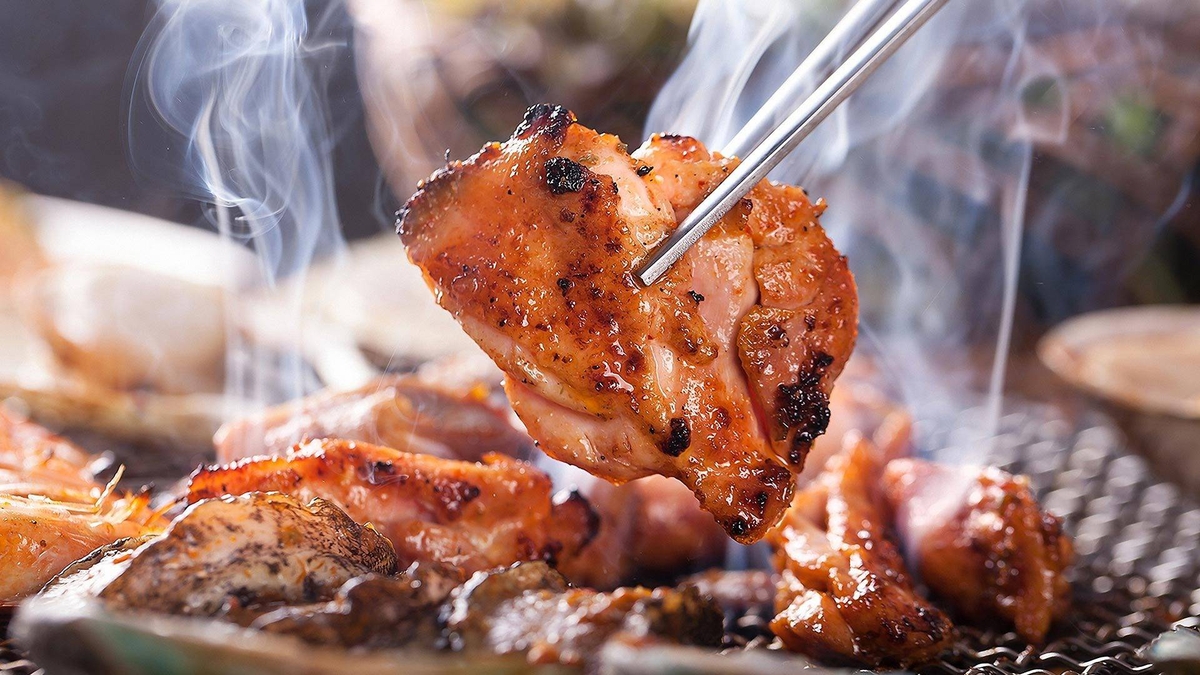Food prices skyrocket
Recently, the price of green vegetables in Hanoi has increased rapidly, many types are even 3 times more expensive than before, making housewives startled.
A survey conducted at many traditional markets showed that the price of each bunch of water spinach doubled from 10,000 VND to 20,000 VND. Vegetables considered “cheap” such as Malabar spinach and red amaranth increased even more, from 5,000 VND to 20,000 VND/bunch. The smallest increase was for mustard greens, but they were also more expensive than before, by about 5,000 VND, up to 15,000 VND/bunch.
“ Previously, with 50,000 VND, you could buy many kinds of green vegetables, now you can only buy 1 or 2 small bunches. At this price, vegetables are as expensive as meat, but you can’t not buy them because green vegetables are indispensable in daily meals.” Ms. Mai Lan (Thanh Tri) complained.

Meanwhile, the sellers said they were not happy to have to sell vegetables at high prices. “ The continuous rain makes vegetables spoil easily, so we can import less and have to pay higher prices than before, so the selling price has to increase. Customers complain, making it difficult for us to sell, many days at the end of the day we have to accept a loss to sell the goods ,” said Ms. Hoa, a vegetable seller.
Not only vegetables but also other basic foods have become more expensive. Currently, pork prices have increased by about 20,000 VND/kg. “I keep seeing the news saying that pork prices have decreased, but I don’t see that the prices at the market have decreased, and have even increased in recent days. When I asked, the sellers just explained that the import price has increased and is likely to continue to increase until Tet.” Mrs. Lan (Vinh Hung) said.
Meanwhile, after a period of sharp decline, chicken eggs have now rebounded sharply. Currently, large eggs are sold for up to 35,000 VND/dozen, an increase of 7,000 VND compared to June. Some seafood products such as snakehead fish, black carp, white carp, and tilapia have also increased in price by about 10,000 - 15,000 VND/kg.
Prices of input materials for processing also fluctuated, of which white sugar price is 29,000 VND/kg, up 2,000 VND; soybean oil price is 130,000 VND/2 liter can, up 10,000 VND; MSG 1kg/package is 70,500 VND, up 7,000 VND; white salt price is 8,000 VND/kg, up 2,000 VND; many types of fish sauce increased from 3,000 - 6,000 VND/bottle.
Ms. Pham Thi Nham, chief accountant of Hanoi Industrial Catering Services Joint Stock Company, said that at this time, the prices of most food items have increased by 15-25%. Typically, in June, her company imported chicken eggs for only about 1,900 VND/egg, but now they have increased by 700 VND, to 2,600 VND/egg. The prices of pork and beef have also increased by 15-20,000 VND/kg.
“ When we asked why prices increased, suppliers replied that input costs such as animal feed, poultry, labor, electricity, water, etc. had increased by 20-25%, so businesses were forced to increase product prices to cover costs ,” said Ms. Nham.

Shops and restaurants take advantage of the situation
In the context of rising food prices and many other costs, many restaurants have quickly changed their price lists, making consumers even more dizzy.
In Ho Chi Minh City, the price of each cup of coffee has increased by 2,000 - 5,000 VND; each bowl of noodles or a plate of rice no longer has many options if customers only spend 30,000 VND like before.
Mr. Thai Quynh, an office worker at Him Lam apartment building (Phuoc Long ward, Ho Chi Minh City) said that in early September, he was surprised when the familiar coffee shop in front of the apartment building quoted a cup of coffee for 40,000 VND, an increase of 5,000 VND compared to the old price.
The shop owner said that the price of raw coffee and other costs had increased, and the rent had also increased by 2 million VND/month, so he had to "ask permission" from customers to adjust the price, increasing each glass of drink by 10-15%.
Although the ADT restaurant in Phuoc Long ward does not directly increase the price of each product, it still makes customers pay more for each food and drink item, due to the addition of 8% tax to the total bill. The bun cha portion at this restaurant was 55,000 VND, an increase of nearly 60,000 VND, the 45,000 VND rib rice dish, customers have to pay the equivalent of 50,000 VND...
In the city center, it is now very difficult for workers to find lunch for less than 40,000 VND/meal. The popular restaurant on Nguyen Binh Khiem Street (Sai Gon Ward) has changed its price since the beginning of September, from 40,000 VND to 45,000 VND/plate. Or along Song Hanh Street (An Khanh Ward), each bowl of noodles and pho has increased by 5,000 - 10,000 VND.

Ms. Linh, a regular customer of the famous noodle shop on this street, shared that when she stopped by the shop to buy a bowl of noodles to take home for her child, she had to pay 80,000 VND, while about 2 months before, the price was only 70,000 VND.
Ms. Thu Nga, an office worker in Saigon ward, also said that on the first morning of the new school year, she took her child to school early. The two of them stopped for breakfast and had to pay 140,000 VND for 2 bowls of pho.
With normal breakfast portions that are surprisingly expensive, she said if a family of four goes out to eat breakfast and drinks coffee, it will cost about 500,000 VND, a number that even people with a good income have to recalculate.
Not only pho noodles but also the most common dishes such as bread and sticky rice are also being increased by 2,000-3,000 VND/serving by shops. Even some popular but popular bakeries have gradually increased their prices from 20,000 VND to 22,000 VND and then to 25,000 VND since the beginning of the year; shops that sold bread for 30,000 VND last year now sell for as low as 35,000 VND/loaf...
Surveying many areas of Ho Chi Minh City, from the center to the suburbs, popular dishes such as beef noodle soup, broken rice, rice noodles, banh canh... have the lowest price of 40,000 VND/portion, most of them are 45,000 VND or more, an increase of 5,000-10,000 VND compared to the beginning of the year.
The reason for the price increase given by the restaurant owner is that the price of raw materials has increased, so in order to maintain quality, the price must be increased.

Ms. Ngoc Lan, owner of a beef noodle shop near Cho Nho (Thu Duc ward) said she has not dared to increase the price but kept the same level of 40,000-45,000 VND/bowl as last year. However, the restaurant's bowls of noodles have less noodles, meat, and sausage. Regular customers have also noticed this, but according to Ms. Lan, "It's better to reduce a little but keep the price, because if guests have to spend 50,000 VND for breakfast, it's too much."
In Hanoi, many restaurants have also quietly increased their service prices. Ms. Tran Thi Nga, on Minh Khai Street (Bach Mai Ward) said that over the past week, she was surprised when the familiar chicken pho restaurant where her family often eats in a small alley increased the price from 35,000 VND/bowl to 40,000 VND. For special bowls (such as pho with thighs, wings...), the price is even higher, from 45,000 - 55,000 VND.
Similarly, many breakfast restaurants in Dong Tau urban area (Yen So ward) also increased the price of each bowl of pho and vermicelli by 5,000 VND.
More aggressively, a Hue beef noodle shop on Nguyen Bac Street (Thanh Tri Commune) has increased the average price by 10,000 VND/bowl. Specifically, the lowest price for a small bowl of Hue beef noodle soup is 35,000 VND to 45,000 VND; a regular bowl is 40,000 VND to 50,000 VND and a full bowl is 15,000 VND higher from 55,000 VND to 70,000 VND.
Street food stalls, which usually cater to low-income earners, are not immune. A self-service restaurant for workers on Tran Thu Do Street has increased the price of each meal by VND5,000. The lowest meal, which used to cost VND30,000, has now increased to VND35,000, and the owner will no longer sell rice and soup unless the customer orders a side dish.
“The price of all ingredients has increased. Now everyone is only buying rice and soup, so we are losing a lot of money. Who can we sell salty food to? I don’t want to increase the price either. It’s just that if we don’t increase the price, we won’t be able to survive, so we have to adjust it.” said the shop owner.
Consumers brace themselves for the blow

Faced with rising commodity prices while income remains stagnant, Ms. Tran Thi Cam Tu (Yen So ward, Hanoi) lamented: In the past, going to the market with 500,000 VND could buy enough food for a family of 4 for several days. But now, if you manage wisely, it is only enough for 2 days.
“This month, my family’s food expenses alone may be 2-3 million VND more, not to mention the children’s tuition and other expenses. Meanwhile, my husband and I’s salary is still only 15 million VND/person. I will have to worry about calculating our expenses so that we still have some left over to prepare for emergencies,” Ms. Tu calculated.
Because of the high prices, Mrs. Mai (Hai Ba Trung ward, Hanoi) has had to calculate and adjust her menu for many days now.
“Going to the market is like solving a math problem. I buy the cheapest items first, and wait for the expensive ones to go on sale. Before, I ate meat every day, but now I have to replace it with tofu and eggs, and I also have to cut down on other expenses like fruit to save money.” she said.
Meanwhile, Ms. Mai Lan, a worker in Sai Dong Industrial Park (Hanoi) confided: “ When commodity prices increase, the people most affected are low-income workers who have no place to live. I am currently renting a house for 2.5 million VND/month. At the beginning of September, this fee was pushed up to 3 million. Then all expenses increased a little bit.
In the context of salary still not increasing, I do not know how to compensate for that price increase. I guess the only way is to cut down on expenses, minimize the less necessary expenses to save for food and living. For now, I will find another place to live that is cheaper, even if the quality is lower, I will have to accept it .

Not only are housewives worried, but rising prices also put great pressure on businesses because they fear losing customers in the context of declining purchasing power.
Explaining the decision to increase the price of each cup of coffee by 3,000 VND and the price of a meal by 5,000 VND, Thanh Viet, owner of Yen Coffee Shop in Binh Trung Ward (HCMC), said that after nearly a year of struggling with the continuous increase in coffee prices, he could no longer maintain the old prices. In addition, the rental price of the premises has increased by about 10%, the price of electricity has also increased by about 5%; water has increased by 400-600 VND per cubic meter earlier this year. Along with that, the cost of hiring part-time employees has increased from 20,000 VND/hour to 22,000 VND.
But it is worth noting that raw material prices have increased continuously. He calculated that on average, seafood prices have increased by about 20% compared to the end of last year; chicken, pork, and beef have also increased by about 15%.
“There has come a time when I cannot bear it without increasing service prices. However, after increasing prices, I am worried about the lack of customers. If prices increase without customers knowing the reason, it is easy for them to “boycott” the restaurant. Or customers will have to give up their old spending habits to save money,” Viet said sadly.
Similarly, Ms. Nguyen Thi Loan (Thanh Tri commune, Hanoi), a food store owner, also said that for many days now, the number of people coming in and out to buy goods has been very sparse.
“Everyone who comes to buy complains about the high prices. Maybe this is the reason why they limit their purchases. According to the calculation at the end of each sale, the number of customers has decreased by 60%, many imported items are not asked for. Even many types of green vegetables are left unsold, I am forced to reduce the price to sell them all, minimizing heavy losses. If this situation continues, I will have to reduce the source of imported goods, otherwise it will be difficult to hold on,” Ms. Loan shared.
iPOS's 2025 F&B market survey shows that the food and beverage industry has faced cost problems since the beginning of 2025, forcing many businesses to consider increasing product prices. Accordingly, up to 49.2% of businesses confirmed that they have plans to adjust selling prices to cope with the pressure of rising raw material costs, basic wages and rental costs. Adjusting selling prices not only helps maintain profit margins, but also improves service quality and customer experience. | |
Source: https://baolangson.vn/hang-thiet-yeu-dua-nhau-tang-gia-nguoi-dan-can-rang-chi-tieu-5064599.html







![[Photo] Prime Minister Pham Minh Chinh chairs a meeting on housing policy and the real estate market.](https://vphoto.vietnam.vn/thumb/1200x675/vietnam/resource/IMAGE/2025/11/11/1762838719858_dsc-2107-jpg.webp)

























































































![Dong Nai OCOP transformation: [Article 4] Reaching national standard products](https://vphoto.vietnam.vn/thumb/402x226/vietnam/resource/IMAGE/2025/11/11/1762825820379_4702-cac-san-pham-trai-cay-chung-nhan-ocop-nongnghiep-174649.jpeg)



![Dong Nai OCOP transition: [Article 3] Linking tourism with OCOP product consumption](https://vphoto.vietnam.vn/thumb/402x226/vietnam/resource/IMAGE/2025/11/10/1762739199309_1324-2740-7_n-162543_981.jpeg)






Comment (0)